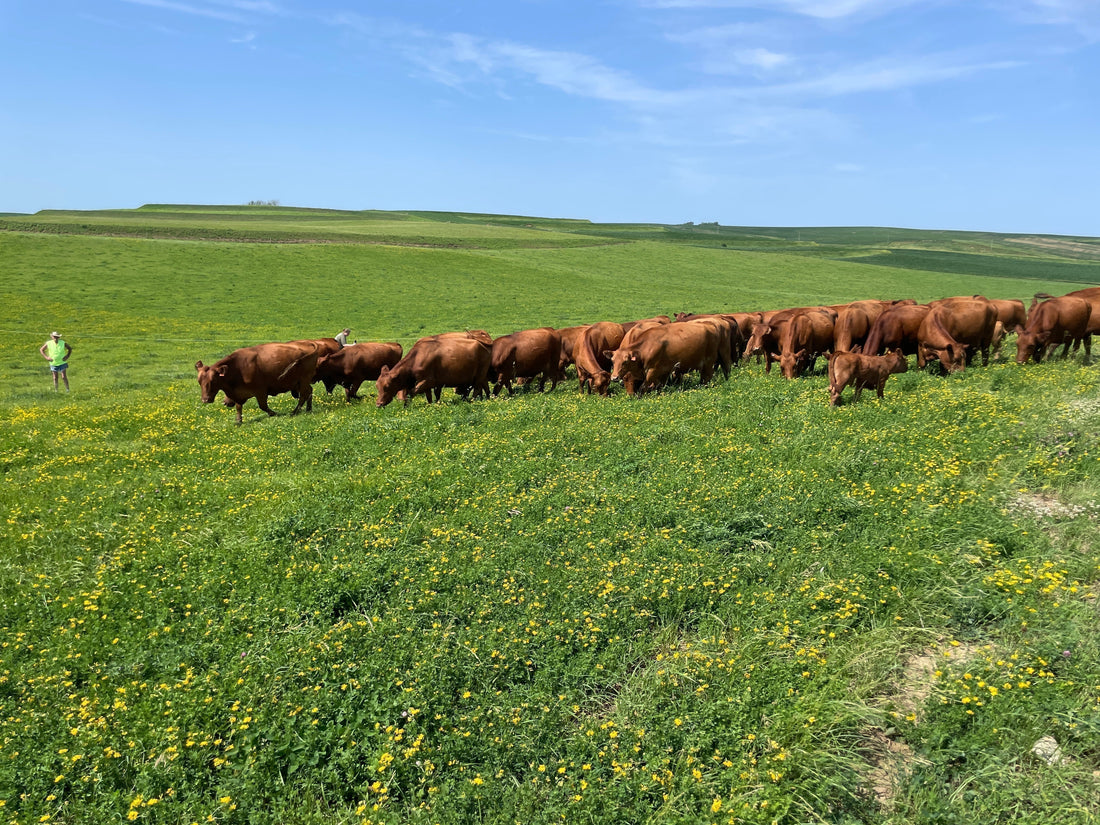
Beyond Grass: The Bloom Behind Great Beef
At first glance, you might think it’s just a hill covered in yellow. But this isn’t a meadow, and it’s definitely not accidental. What you're looking at is a pasture in full bloom: planned, managed, and full of life.
The Power of Diverse Plants
Right now, bird’s-foot trefoil has taken center stage, painting our warm and cool season pastures gold. It offers our cows a non-bloating, high-quality, high-energy bite. Which, if you’ve ever had to worry about bovine bloat, you know is no small favor. (Think of it like that uncomfortable feeling after a really big meal, but for a 1,200-pound animal!) Cows aren’t exactly known for eating in moderation, so giving them a plant that lets them graze without, shall we say, exploding, is a win all around. Underneath, and peeking through the yellow, we’ve also got sweet clover, white clover, red clover, cicer milkvetch, and purple prairie clover, each doing their part in this diverse little pasture community.

Patience, Faith, and Investment
It’s easy to look out across a pasture like this and imagine it simply sprang up. But getting these plants settled, truly established, takes a special kind of patience, some years, a lot of faith. You see, some seasons you just look out here, and it feels like nothing’s happening at all. You might even get a little sad, thinking it just didn't take, especially when you consider that sourcing these specific, non-GMO seeds is quite an investment. Look closer at some of these little ones, like the bird’s foot trefoil or the cicer milkvetch. They’re not the type to just leap out of the ground the first season. No, you actually have to coax them along, sometimes for more than a year, really trusting that they’re putting down roots and doing their quiet work far beneath the surface. But once they truly anchor themselves, they’re here to stay, and they give back in ways you can’t always see right away.

Legumes and Their Healing Power of Soil
Legumes like these are the overachievers of the pasture. They pull nitrogen from the air and fix it into the soil, which helps everything around them grow better. This is a stark contrast to conventional row-crop farming. Years of continuous harvesting in traditional row cropping can severely deplete the soil of essential nutrients, often necessitating substantial, annual applications of synthetic fertilizers like liquid nitrogen or anhydrous ammonia. This is a cycle we recognized and proactively addressed. In the early 90s, our family began moving away from these practices, starting with no-till farming (for erosion control) and planting cover crops (for soil amending) with our row crops. This made us among the early adopters in the Iowa agricultural world. Today, you'll see some innovative Iowa farmers using many of these intelligent practices, planting cover crops like rye, oats, clover, or radishes to safeguard and enrich their fields. While the vast majority still lean on topical chemical applications, this commitment to soil health is slowly gaining ground.
Our deep root system, combined with the diverse array of grasses and other plants, works wonders for comprehensive soil health. It helps build up organic matter and increases rain water infiltration, allowing more of the rain to soak into the ground instead of running off. And that "running off" isn’t just a farm issue. It affects most landscapes, carrying soil and pollutants from both rural fields and city streets into waterways. Downstream, this can overwhelm water systems and lead to issues like city-wide watering restrictions. It also improves the soil structure so it then holds water better, like a sponge. All this fosters a flourishing underground world of microbes and beneficial fungi. This isn't just about feeding plants to feed cows; it's about making the soil itself more robust and sustainable. These plants also help the cows digest their food more efficiently, which means healthier animals and better gains. And yes, some come with a risk of bloat, but that’s where good planning and non-bloating varieties come in.

Careful Grazing for a Stronger Pasture
We manage our grazing carefully, giving the plants time to rest and regrow before cattle come back through. If you let cows graze a spot too hard, it simply won’t recover. But if you move them through at just the right time, you'll see the field rebound, stronger than before.

Remembering What Was Lost
And here’s the part that truly takes our breath away. Since converting our row crops to pasture, the landscape itself has undergone a stunning transformation. It literally stops me in my tracks. We’re seeing plants pop up that vanished years ago. Just this past weekend, walking out to the pasture in my flip-flops. (Yes, flip-flops. Let's just say a quick escape from Minneapolis meant I wasn't exactly dressed for serious pasture jaunts, but that didn't deter me.) I stopped, delighted to witness my childhood returning like an old friend. The land is starting to bloom in ways we haven't witnessed since our own youth, not just beneath our boots, but all around us.
When I was in grade school, I spent hours collecting flowers from the ditches: wild Iowa prairie roses, purple coneflowers, and little clovers of every shade. I would bundle them into bouquets for my grandma; we were lucky, they lived next door. Back then, the roadsides were full of color. But by the time I reached junior high, all of it was gone. The flowers disappeared, the ditches turned to uniform grass, and the vibrant palette of our childhood summers faded to green. Now, alongside the wild roses have come the milkweeds, in all their regal sprawl. Monarch butterflies have found their way home, dancing over the tall grasses like they own the place. Milkweed, once just another part of the field, was treated like a weed to pull; we were told it would ruin the crops if it went to seed. All this vibrant life had been wiped out by over-spraying and overworking the land. But now, the latent seed bank is waking up, and it feels like the land is remembering something we nearly forgot, a long-held breath finally being released. Plants that had vanished are coming back, waking from decades of dormancy like they never left at all. It’s a slow resurrection, but it’s real, and it’s beautiful.

Managing the Wild: Thistles and Balance
While we celebrate the awakening of the latent seed bank, it's not always working entirely with us. Sometimes, it brings forth some challenging characters. That's why, if you notice certain fields looking a little short, it's often just us with the mower. When the cattle can’t keep up, we step in to knock back plants that could cause harm. Take the Nodding thistle, for instance, also known as the Musk thistle. It’s a native of Europe and Asia that landed here back in the 1850s, and around our place, we jokingly call it Enemy Number One. Yes, it grows tall and has a striking purple flower, but it’s incredibly aggressive if left unmanaged. It can scratch a cow’s eye and lead to pinkeye, which could spread through a herd about as fast as it does through a kindergarten classroom. Mowing helps keep things safe, encourages tender regrowth, and keeps the balance just right.

Final Thoughts: The Worth of Care
All this dedicated care, the seeding, the precise timing, and the quiet vigil of anticipation, truly adds up. A pasture like this doesn’t come from tossing out a seed mix and hoping for the best. It’s slow work. Sometimes it’s frustrating. But then one day you walk the hill, and everything is blooming, and the cows are grazing contentedly in the sun. You realize the land is not just producing. It’s healing.
And that’s worth every stubborn seed.
